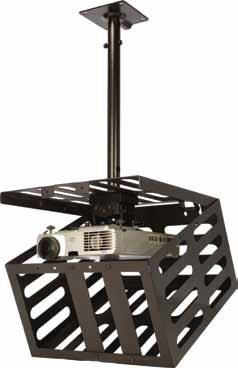Mount Technology Continues To Evolve With The Display Market
by Ryan Abeling
Display and projector mounts are important tools that integrators work with each day out in the field, but their significance is often overlooked. Since the emergence of display technology, companies have constantly devised new and more flexible ways to hang these devices on walls or ceilings. As the products get slimmer and lighter, so do the mounts that hold them, and integrators stand to benefit the most from their ease of use.
Displays and projectors come in many shapes and sizes, but as Tom Noack, marketing manager for Premier Mounts notes, mount technology has evolved right along with these products. “Mounting technology is getting more and more sophisticated,” he said. “Mounts have evolved to become highly engineered, intricate assemblies that fit just about any display. They allow precise adjustments, some of which are tool-free. Some have quickrelease mechanisms and are accurate enough to drop back into the final projection position after releasing the projector or flat panel for service or repair. Overall, mounts are becoming more universal, easier to use, and more precise, and have added features like security and cable management.”
To keep the technology fresh, manufacturers have consulted with integrators to create mount designs that complement the technology being installed, as well as the actual placement process. “Our product management and design teams meet with professional installers to gain firsthand knowledge about the intricacies and demands of mounting solutions,” explained Nathan Bohl, product manager at Chief Manufacturing.
“From these meetings, we design installer-inspired ideas into each product. We also continue to investigate new materials and manufacturing processes to produce new, lower-profile mounting solutions.” Such attention to detail has created many new marginbuilding opportunities for integrators.
With a large array of mounting technology available for integrators , finding the right product that will continue to make them a profit is essential. “Don’t be afraid to buy the best mounts available,” Noack said. “These mounts usually enable integrators to speed up installation and make maintenance less costly for them and the customer. All our mounts come with a complete set of installation hardware. There’s literally everything but the electric drill.”
While installation time is money, creating an original design is also essential to differentiating a contractor from the competition. “Having a wide variety of mounting solutions for an entire installation can help integrators customize their design and installation,” Bohl noted. “They can now easily integrate peripheral components into an installation, keeping revenues up and costs down due to ease of installation.”
In keeping with originality, manufacturers say the future will bring more innovation into the world of mounts, allowing integrators to create even more complex room designs. “The demand for thinner/lower-profile solutions will continue to grow, especially as these ultra-thin displays start entering the professional market,” Bohl said. “Continual demand of these thinner flat panels will be driving both product features and aesthetic design.”
The versatility and sophistication of the mounts will continue to flourish as well. “There will be more motorization involved as more mounts connect to integrated office and home automation systems,” Noack predicted. “Mounts may also develop into standalone media centers for digital signage, home, and industrial applications. In general, our vision is for the mounting system to play a significantly larger role in the functionality of the end system.”
